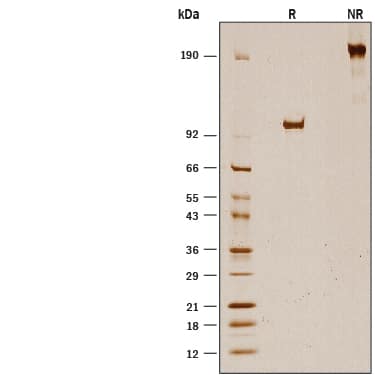Recombinant Human Fibrillin-1/FBN1 Fc Chimera Protein, CF
R&D Systems, part of Bio-Techne | Catalog # 10224-FI

Key Product Details
Source
NS0
Accession #
Structure / Form
Disulfide-linked homodimer
Conjugate
Unconjugated
Applications
Bioactivity
Product Specifications
Source
Mouse myeloma cell line, NS0-derived human Fibrillin-1/FBN1 protein
| Human Fibrillin-1 (Ala25-Thr660) Accession # P35555 |
IEGRMD | Human IgG1 (Pro100-Lys330) |
| N-terminus | C-terminus |
Purity
>95%, by SDS-PAGE under reducing conditions and visualized by silver stain.
Endotoxin Level
<0.10 EU per 1 μg of the protein by the LAL method.
N-terminal Sequence Analysis
Ala25
Predicted Molecular Mass
95 kDa
SDS-PAGE
97-108 kDa
Activity
Measured by its binding ability in a functional ELISA.
When Recombinant Human MFAP4 (Catalog # 10230-MF) is immobilized at 0.5 μg/mL (100 μL/well), the concentration of Recombinant Human Fibrillin-1/FBN1 Fc Chimera (Catalog # 10224-FI) that produces 50% of the optimal binding response is 0.1-0.6 μg/mL.
When Recombinant Human MFAP4 (Catalog # 10230-MF) is immobilized at 0.5 μg/mL (100 μL/well), the concentration of Recombinant Human Fibrillin-1/FBN1 Fc Chimera (Catalog # 10224-FI) that produces 50% of the optimal binding response is 0.1-0.6 μg/mL.
Scientific Data Images for Recombinant Human Fibrillin-1/FBN1 Fc Chimera Protein, CF
Recombinant Human Fibrillin-1/FBN1 Fc Chimera Protein Binding Activity
When Recombinant Human MFAP4 (Catalog # 10230-MF) is coated at 0.5 µg/mL, 100 µL/well, Recombinant Human Fibrillin-1/FBN1 Fc Chimera (Catalog # 10224-FI) binds with an ED50 of 0.1-0.6 µg/mL.Recombinant Human Fibrillin-1/FBN1 Fc Chimera Protein SDS-PAGE
1 μg/lane of Recombinant Human Fibrillin-1/FBN1 Fc Chimera (Catalog # 10224-FI) was resolved with SDS-PAGE under reducing (R) and non-reducing (NR) conditions and visualized by silver staining, showing bands at 97-108 kDa and 190-220 kDa, respectively.Formulation, Preparation and Storage
10224-FI
| Formulation | Lyophilized from a 0.2 μm filtered solution in PBS with Trehalose. |
| Reconstitution | Reconstitute at 500 μg/mL in PBS. |
| Shipping | The product is shipped at ambient temperature. Upon receipt, store it immediately at the temperature recommended below. |
| Stability & Storage | Use a manual defrost freezer and avoid repeated freeze-thaw cycles.
|
Background: Fibrillin-1/FBN1
References
- Robertson, I. et al. (2011) Biochem. J. 433:263.
- Corson, G.M. et al. (1993) Genomics 17:476.
- Maslen, C.L. et al. (1991) Nature 352:334.
- Hanford, P.A. et al. (1991) Nature 353:395.
- Werner, J.M. et al. (2000) J. Mol. Biol. 296:1065.
- Downing, A.K. et al. (1996) Cell 85:597.
- Smallridge, R.S. et al. (2003) J. Biol. Chem. 278:12199.
- Reinhardt, D.P. et al. (1997) J. Biol. Chem. 272:7368.
- Raghunath, M. et al. (1999) J. Cell. Sci. 112:1093.
- Wallis, D.D. et al. (2003) J. Cell. Sci. 90:641.
- Jensen, S.A. et al. (2016) Biochem. J. 473:827.
- Sherratt, M.J. et al. (2001) Micron. 32:185.
Long Name
Fibrillin-1
Alternate Names
ACMICD, Asprosin, Fibrillin 1, GPHYSD2, SSKS, WMS2
Entrez Gene IDs
2200 (Human)
Gene Symbol
FBN1
UniProt
Additional Fibrillin-1/FBN1 Products
Product Documents for Recombinant Human Fibrillin-1/FBN1 Fc Chimera Protein, CF
Product Specific Notices for Recombinant Human Fibrillin-1/FBN1 Fc Chimera Protein, CF
For research use only
